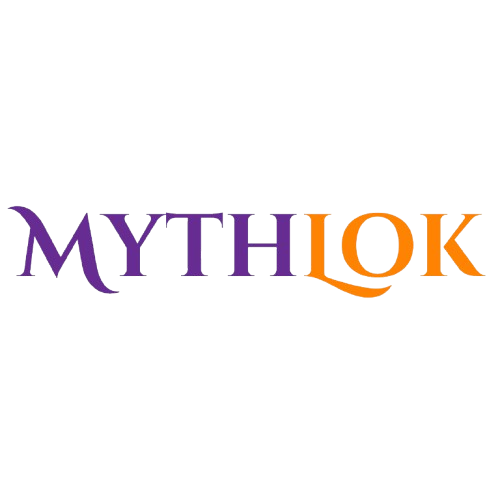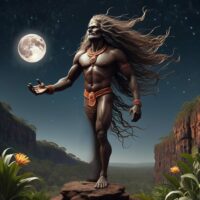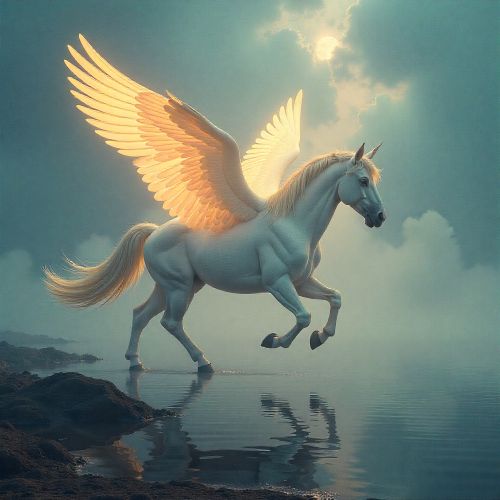Dharramulan : The One Legged God
Listen
At a glance
| Description | |
|---|---|
| Origin | Wiradjuri Mythology |
| Classification | Gods |
| Family Members | Biame (Father), Birrangulu (Mother) |
| Region | Australia |
| Associated With | Natural World, Male Initiation, Guardian |
Dharramulan
Introduction
The Wiradjuri people, one of Australia’s largest Aboriginal groups, hold a deep cultural heritage rooted in spiritual beliefs and mythology. At the heart of their traditions lies Dharramulan, a profound figure integral to their moral and ceremonial practices. Serving as a link between the earthly and the spiritual, Dharramulan embodies the principles of creation, law, and sacred customs.
Within Wiradjuri stories, Dharramulan is both a creator and a cultural hero, symbolizing the interplay between humanity, nature, and the divine. His presence is intertwined with the land, the cosmos, and the spiritual essence of the Wiradjuri nation, weaving themes of origin, ethics, and the unity of the physical and metaphysical.
Physical Traits
Dharramulan is characterized by striking and symbolic physical features that reflect his dual connection to the earthly and spiritual realms. Often described as tall and commanding, his form exudes strength and mystery. His dark skin is likened to the fertile soil of the Wiradjuri lands, while his flowing hair echoes the rivers weaving through the landscape.
A unique feature of Dharramulan is his single leg, a powerful symbol of his role as a mediator between realms. In some accounts, he is portrayed with one arm or adorned with emu-like traits, such as feathers or a long neck, emphasizing his bond with the natural world and its creatures. These elements underscore the significance of fauna in Wiradjuri culture. His face is sometimes hidden, enhancing the enigmatic aura surrounding him. Artistic interpretations differ but consistently honor his profound importance in Wiradjuri spirituality and traditions.
Family
In Wiradjuri cosmology, Dharramulan is deeply connected to significant ancestral figures, reflecting the intricate web of relationships within their spiritual framework. As the son of Baiame, the revered creator and lawgiver, Dharramulan carries forward his father’s legacy of maintaining order and guiding the community. Baiame’s influence extends through Dharramulan, linking the realms of creation and tradition.
Dharramulan’s mother, Birrangulu (or Cunnumbeillee in some versions), embodies the nurturing essence of the earth. Her union with Baiame symbolizes the harmony between land and sky, a vital concept in Aboriginal spirituality. This lineage highlights Dharramulan’s role in bridging these realms, emphasizing themes of balance and interconnectedness central to Wiradjuri beliefs. Through these familial ties, Dharramulan becomes a vital figure in sustaining both cultural and spiritual harmony.
Other names
Dharramulan is referred to by multiple names across Aboriginal cultures, reflecting the linguistic diversity and oral storytelling traditions of these communities. Variations such as Daramulun, Dharamalan, and Tharamulun capture regional differences while preserving his identity as a revered figure. These alternate names emphasize the flexibility of oral traditions in adapting to local dialects while maintaining the essence of his role and significance. This diversity underscores the shared yet distinct ways in which Aboriginal communities honor his legacy, ensuring his stories endure across generations.
Powers and Abilities
Dharramulan’s powers and abilities place him at the heart of both spiritual and earthly domains. He is known for his profound healing abilities, addressing not just physical ailments but also restoring spiritual harmony within individuals and communities. This duality highlights his role as a protector and nurturer of the Wiradjuri people.
As a custodian of natural forces, Dharramulan wields control over weather patterns, ensuring the land’s fertility and the survival of his people. His influence extends to the stars, where his guidance aids in the creation of seasonal calendars essential for navigation and agricultural cycles. Through his deep connection to nature, Dharramulan exemplifies the balance between human life and the environment.
In Wiradjuri ceremonial practices, particularly Bora initiation rites, Dharramulan serves as a spiritual overseer, imparting sacred knowledge and guiding initiates toward adulthood. His role as a mediator between humans and ancestral spirits ensures that cultural laws are upheld and traditions remain alive. His association with the emu, a totem of fertility and sustenance, reinforces his embodiment of nature’s abundance and the responsibilities of living in harmony with it. Through these attributes, Dharramulan represents both guidance and guardianship in Wiradjuri culture.
Modern Day Influence
Dharramulan’s legacy remains a vital thread in the fabric of contemporary Wiradjuri culture and beyond, symbolizing resilience and the preservation of Indigenous heritage. Renewed efforts to revitalize Aboriginal traditions have placed his stories at the forefront of cultural education, enriching both younger generations and the broader Australian community with deeper insights into Wiradjuri beliefs.
Artists and creators find inspiration in Dharramulan’s enigmatic presence, weaving his image and narratives into modern expressions like visual art, literature, and public installations. These interpretations not only celebrate his significance but also serve as a testament to the enduring relevance of Wiradjuri mythology in fostering cultural identity and dialogue about the importance of preserving Indigenous knowledge.
In addition, Dharramulan’s role in sacred ceremonies remains a cornerstone of cultural practice. These rites, sustained through collective efforts, reinforce the spiritual bonds that connect the Wiradjuri people to their ancestors. By upholding these traditions, the community ensures that ancient wisdom continues to inform and guide modern life.
Dharramulan’s growing presence in public forums and cultural initiatives also highlights the broader movement toward reconciliation and recognition of Indigenous contributions to Australia’s identity. His stories serve as powerful reminders of the richness of Aboriginal worldviews, offering valuable lessons in respect, harmony, and sustainability. Through his enduring influence, Dharramulan embodies the intersection of heritage and contemporary relevance, bridging the past and present with wisdom and grace.
Related Images
Source
Mathews, R. H. “The Wiradjuri People.” Journal of the Royal Society of New South Wales 38 (1904): 203–381.
Miller, James. Koori: A Will to Win—The Heroic Resistance, Survival & Triumph of Black Australia. Sydney: Angus & Robertson, 1985.
Petheram, R. J., and F. H. Worms. “The Riverine Tribes of New South Wales.” Oceania 12, no. 4 (1942): 368–386.
Tindale, Norman B. Aboriginal Tribes of Australia: Their Terrain, Environmental Controls, Distribution, Limits, and Proper Names. Berkeley: University of California Press, 1974.
Wiradjuri Council of Elders. Wiradjuri Heritage Stories. Wagga Wagga: Wiradjuri Council Publications, 2010.
Australian Museum. “Daramulum—Ancestral Being.” Australian Museum. (Accessed October 2023).
New South Wales Government. “Wiradjuri People and Heritage.” NSW Aboriginal Affairs. (Accessed October 2023).
Frequently Asked Questions
What is lorem Ipsum?
I am text block. Click edit button to change this text. Lorem ipsum dolor sit amet, consectetur adipiscing elit. Ut elit tellus, luctus nec ullamcorper mattis, pulvinar dapibus leo.
What is lorem Ipsum?
I am text block. Click edit button to change this text. Lorem ipsum dolor sit amet, consectetur adipiscing elit. Ut elit tellus, luctus nec ullamcorper mattis, pulvinar dapibus leo.
What is lorem Ipsum?
I am text block. Click edit button to change this text. Lorem ipsum dolor sit amet, consectetur adipiscing elit. Ut elit tellus, luctus nec ullamcorper mattis, pulvinar dapibus leo.
What is lorem Ipsum?
I am text block. Click edit button to change this text. Lorem ipsum dolor sit amet, consectetur adipiscing elit. Ut elit tellus, luctus nec ullamcorper mattis, pulvinar dapibus leo.
What is lorem Ipsum?
I am text block. Click edit button to change this text. Lorem ipsum dolor sit amet, consectetur adipiscing elit. Ut elit tellus, luctus nec ullamcorper mattis, pulvinar dapibus leo.






